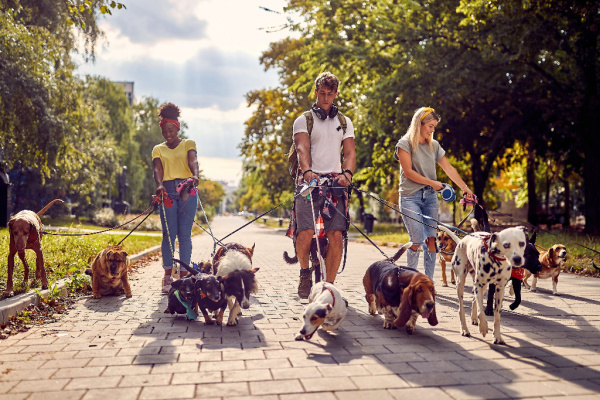February 22 might just seem like another day to you, but your dog may have had this day starred all month. It’s National Walk Your Dog Day. What can be better than spending time with your best friend (your owner), exploring the outside world, exercising your body and mind?
Of course, if you’re a dog lover, you know how important their walks are. But sometimes you might find yourself running out of time, having a particularly hectic day, and you only have time to just let your pup out to pee before bringing him back inside. Or maybe you’ve gotten used to having that doggie door, so your pooch can take himself out whenever he needs to, free to play in the yard as he pleases. That’s a great option, right?
If this sounds like you, you’re not alone. As the Washington Post reports, a 2011 study from Michigan State University on the benefits of dog-walking found only two-thirds of its subjects routinely walked their dogs. But while this may be a time saver, it’s not the best for your dog’s health and well being. According to experts, this forgoing of walks can significantly affect your dog’s emotional and physical well-being.
“First of all, dogs don’t exercise by themselves, for the most part,” says Stephanie Borns-Weil, an assistant clinical professor at the Cummings School of Veterinary Medicine at Tufts University. The amount of exercise a dog needs varies based on age, breed and health – it can be as little as 30 minutes a day or as much as a few hours – but virtually all dogs need exercise in some form.
The typical yard, Borns-Weil says, just doesn’t offer enough stimulation to prompt an adequate amount of movement. Unless you’re spending time playing with your dog, “they’re just going to sit there,” she says, “because the space is familiar.” She compared it to reading the same book over and over again, or seeking enrichment by hanging out in your bathroom.
This need for exercise, while crucial, isn’t even the most important reason to walk your dog. They may or may not get some exercise in the yard, Borns-Weil says, “but they’re not getting companionship [from their human], and they’re not getting the mental stimulation that comes from seeing new things, or, from the point of view of a dog, sniffing new things.” Dogs who don’t have these needs met “are subjected to some of the same effects of long-term chronic stress on their health that people are,” she says, ranging from depression and anxiety, to problems with the immune system. (Studies have found that dogs in shelters, too, benefit from direct human interaction, which reduces stress and stress-related behaviors.)
To help your dog get the most out of her walk, let her explore. “Sniffing is the way that dogs experience the world,” says Valli Fraser-Celin, a humane dog training advocate. Where humans have 6 million olfactory receptors, research shows dogs can have up to 300 million; it’s how they acquire information about their environment and communicate. Dogs can tell which animals have been nearby – including sniffing out their gender and information about their health. A friend’s dog walker used to equate the act of sniffing to a dog “checking their email.”
But so often, humans hurry them along, prioritizing exercise (or their own schedule) over their dog’s interest in the world around them. “It would be like taking me to the Smithsonian Institute,” Borns-Weil says, “and I’m wanting to stop and look at the exhibits, and somebody says, hey, hurry up, we’re just exercising, keep walking.”
Allowing a dog to pull off to the side and sniff whenever he wants can feel wrong to those accustomed to outdated, dominance-focused training methods, which prioritize obedience above all else (and which are based on a long-debunked, but still persistent theory). Fraser-Celin warns against getting wrapped up in that mind-set.
It isn’t necessary that your dog walk obediently behind or beside you, or that they only stop to sniff when you grant permission. What’s important is that you pay attention to what they’re communicating, and help them meet their needs. “If your dog wants to sniff every blade of grass,” Fraser-Celin says, “then that’s what they want to do on their walk.”
After some amount of time, you can usher them to a new area to sniff, or you might even designate a portion of the walk for sniffing and a portion for exercise. But, above all, guardians need to take the animals’ lead, Fraser-Celin says, “rather than focusing on what our intentions are for the walk.” And if your dog isn’t into meeting strangers, canine or human, don’t feel pressured to acquiesce to those who insist their dog “is friendly!” or “all dogs love me!”
“Whenever you’re out in the world, it’s important to be an advocate for your dog’s needs,” Borns-Weil says. “Your dog is not public property.”
For dogs just learning leash skills, Fraser-Celin recommends starting in the house, or another area free from distractions, and using a well-fitted harness to take the pressure off their neck. (A fanny pack full of training treats can also come in handy.) If more help is needed, you might consider working with a positive reinforcement trainer. And if you feel your dog is uncomfortable walking, or has developed what seem like new fears or behavioral issues, Borns-Weil recommends a checkup to rule out medical problems. If your dog has a significant amount of anxiety around walking, it may be an issue for a veterinary behaviorist.
Think of it this way: spending this time with your dog is important for his health and well-being, yes, but it’s just as important for yours. Studies have shown what many dog lovers likely already know – that canine companionship and dog walking can reduce stress, benefit health, lower medical costs and decrease depression and anxiety. It’s a gift we can give each other.
—
Photo Credit: Lucky Business / Shutterstock.com
